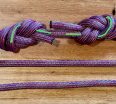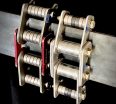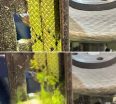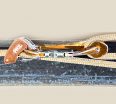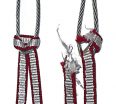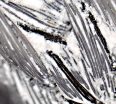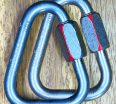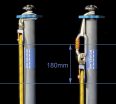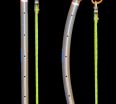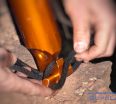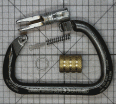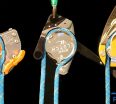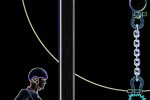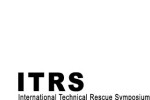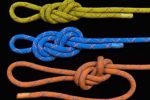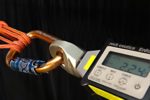Rope Materials
As roping technicians, most of the ropes we use today are kernmantle, meaning that they are a collection of core fibres providing much of the tensile strength, surrounded by a sheath which provides both strength and abrasion resistance. This word comes from the German words ‘kern’ meaning core and ‘mantel’ meaning jacket. There is much variation and corresponding confusion around the materials, and their associated properties, used in rope manufacture. This report presents a discussion of materials used in rope manufacture. Note that some of the terms used refer to organic chemistry (chemistry related to compounds containing carbon atoms). Other terms refer to trademarked products developed by companies for commercial use.
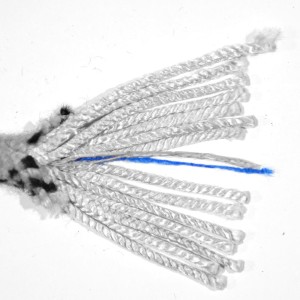
The materials used in rope manufacture can create fibres with varying strength, stretch, ductility and density. They will also vary in their response to heat, UV radiation, water and chemical exposure. Broadly speaking, different fibres have different properties and rope manufacturers can combine them to achieve a rope capable of serving a particular purpose. For example, a rope may have an aramid core to achieve its strength and a polyester sheath to provide some UV resistance. Knowing the construction of your ropes will help you to use your equipment effectively.
These properties are affected not only by the chemical make up of the molecules, but also by how the molecules stick together, how they are woven in to fibres and how the fibres are woven into a rope. For example, the molecules used in rope manufacture discussed below all fall into the class of ‘polymers’. Polymers are long molecules made of many repeated subunits bonded together. On a molecular level, polymers used for ropes and cord are like a bowl of spaghetti. Individual molecules are quite strong but the overall strength depends on how well those molecules, or strands of spaghetti, stick together. Chemical engineers can make the strands stick together better by crosslinking the chains, effectively riveting the chains together, but a lot of the toughness and flexibility may be lost. They can also increase strength without compromising toughness by using the weak hydrogen bonding between strands. Making the strands longer will increase the strength, and having them all oriented in the same direction increases the strength along that direction dramatically.
Polyamides
A polyamide is a polymer made of repeating units of amide groups. There are many different types of polyamides and they can be naturally occurring or artificial.
The bonds in the polyamide can be described as aliphatic, semi-aromatic or aromatic. These terms are chemical descriptors and refer to how the molecule is constructed. The different bonding structures produces products with very different properties, such as nylon and Kevlar described below.
Nylon is an aliphatic polyamide. In general, nylon creates supple fibres with good strength and stretch. Nylon absorbs water and loses some strength when wet. Many rope manufacturers use nylon 6,6 or nylon 6. Cordura is a nylon 6,6 product trademarked by Invistia. Nylon 6,6 has better hydrogen bonding, leading a stronger product with a higher melting point when compared with Nylon 6. Nylon can be identified as it smells slightly fishy on burning.
An aramid is an aromatic polyamide. The name is a blend of these two words. In general, aramid fibres have excellent strength to weight ratios, low stretch, a high resistance to heat, and good resistance to abrasion. They are sensitive to UV radiation so we often have a nylon or polyester mantels woven over aramid cores. Technora, Twaron (registered by Teijin) and Kevlar (registered by DuPont Performance Materials) are registered brand names of aramid products. They are often opaque yellow in colour.
Polyesters
Polyester is made from repeating units of ester groups, forming fibres that are hydrophobic, strong, abrasion resistant, and have some resistance to stretch and UV light. Sterling Rope uses the term HTP to refer to its High Tenacity Polyester ropes. Vectran, trademarked by Kuraray, is an example of an aromatic polyester. PET, used for manufacturing plastic bottles, is an example of a semi-aromatic polyester produced in a very different form.
Polyethylene
Polyethylene is made from repeating ethylene groups. UHMwPE or Ultra High Molecular weight Polyethylene refers to a particularly large polyethylene molecule. In general, polyethylene creates strong smooth fibres which float, and have excellent resistance to abrasion. The low coefficient of friction makes it a poor choice for prusiking, and requires sewing or splicing as knots either slip or weaken the cord too much. Dyneema, trademarked by DSM, and Spectra, trademarked by Honeywell, are both UHMwPE fibres.
Polypropylene
Polypropylene is made of repeating propylene groups. Polypropylene is used in fibres where ropes need to float, be lightweight and water resistant. In general, they have low resistance to UV light, heat and abrasion. Polypropylene smells like a candle on burning.
Below is a table exploring the specifications of some examples of these materials to illustrate the differences in properties. We have chosen a few specific examples but please note that there are often many different products within a class. Ropes are constructed from these fibres with a variety of weaves, coatings and methodologies. This will create an end product with particular properties that may vary from the original source materials. Wherever possible, we have sourced the data from the manufacturer of a specific product. The sources of information and explanations of specifications are listed below.
|
Source of Information |
Tenacity | Tensile Modulus | Elongation at breaking | Density | Decomposition point | UV stability | Response to water |
Other notes |
|
| Polyamide -Nylon 6 (Nexis Fibres) | (1) (2) | 0.55- 0.85 N/tex | 20.6% – 46% | 1.14g/cc | 350C | Poor | Some strength reduction when wet. | Poor resistance to abrasion. | |
| Polyamide -Aramid (Technora) | (3) | 2.47 N/tex | 73 GPa | 4.6% | 1.39g/cc | 500C | Poor | No strength reduction when wet. | Good resistance to abrasion. |
| Polyamide – Aramid (Kevlar 29) | (4) | 2.03 N/tex | 70.5 GPa | 3.6% | 1.44g/cc | 427-482C | Poor | No strength reduction when wet. |
|
| Polyester – HTP (TP785) | (5) | 0.80-0.82N/tex | 13.0-15.5% | 1.38g/cc | 260C | Good | Minimal strength reduction when wet. | Good resistance to abrasion. | |
| Polyester –(Vectran HT) | (6) (7) | 2.29N/tex | 74.6GPa | 3.8% | 1.41g/cc | 400C | Good | No strength reduction when wet. | Good resistance to abrasion. |
| Polyethylene – (Spectra 1000) | (8) (9) | 3.00-3.75N/tex | 97-113GPa | 2.9-3.5% | 0.97g/cc | 300C | Very good | Repels water. | Low coefficient of friction.
Excellent resistance abrasion. |
| Polypropylene – HT (TP752) | (5) | 0.61-0.62N/tex | – | 20% | 0.91g/cc | 170C | Poor | Good water resistance. | Poor resistance to abrasion and heat. |
Tenacity: A measure of the breaking force of the fibre divided by the linear density. It is similar to a strength to weight ratio.
Tensile Modulus: This is a measure of the stiffness of the material. It is the ratio of the stress or pressure felt over the strain, or ratio of deformation. A high figure indicates a high resistance to stretch. It is not an indication of strength nor elasticity.
Elongation at breaking: Percentage stretch at point of breaking.
Density: A density value below 1 will float on water.
(1) http://www.nexisfibers.com/pa6-for-ropes-nets-and-weaving
(2) http://www.nexisfibers.com/safety-data-sheets
(3) http://www.teijin.com/products/advanced_fibers/aramid/contents/aramid/technora/eng/technora_top_e.html
(4) http://www.dupont.com/content/dam/dupont/products-and-services/fabrics-fibers-and-nonwovens/fibers/documents/DPT_Kevlar_Technical_Guide_Revised.pdf
(5) https://www.tp-industrial.com/wp-content/uploads/2015/07/12004_tpi-folder.pdf
(6) http://www.kuraray.co.jp/vectran/en/tokutyou/s01.html
(7) http://www.vectranfiber.com/properties/
(8) https://www.honeywell-spectra.com/products/fibers/
(9) https://www.honeywell-spectra.com/?document=fiber-capability-guide&download=1
Many thanks to Mikl Law and Jeff Crass for their informed input into this article.
© Richard Delaney, RopeLab, 2016.


